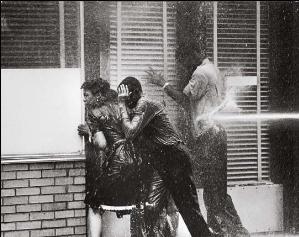General Discussion
Related: Editorials & Other Articles, Issue Forums, Alliance Forums, Region ForumsA Contemporary Artist Is Helping Princeton Confront Its Ugly Past
Princeton is hardly the first college to reckon with the racial injustice that defined its founding, and to seek a kind of rhetorical cleansing.
11/13/2017 02:01 pm ET Updated 1 day ago

By Jacoba Urist
These days, public sculptures often seem seem intertwined with historical regret. There’s the bronze Robert E. Lee statue in Charlottesville, Virginia; the Roger Taney effigy outside the Maryland State House; the Confederate soldier in front of North Carolina’s Durham County Courthouse. This historical regret has inspired a rush to topple sculptures. But the feelings of remorse and shame have also stirred impassioned debate about the ways in which art ought to reflect America’s complex legacy: Who should embody the values of today? What distinguishes art from political propaganda? And which artists will fill the empty plinths?
Princeton University has one answer to these questions with a new public-art project that confronts the school’s participation in the nation’s early sins. On Monday, the university unveiled Impressions of Liberty, by the African American artist Titus Kaphar. The sculpture is the conceptual core of a campus-wide initiative that begins this fall and aims to reconcile the university’s ties to slavery. The Princeton and Slavery Project’s website has released hundreds of articles and primary documents about slavery and racism at Princeton, which was once jokingly described as the “northernmost outpost of Southern culture.” There is perhaps no better-suited artist than Kaphar to help the school grapple with past inequities and consider the stains of its founders. His art concentrates on the way history is remembered, highlighting the figures and inconveniences, as one 2009 Art in America review described it, who are “habitually … written out of grand historical narratives.”
Princeton is hardly the first college to reckon with the racial injustice that defined its founding, and to seek a kind of rhetorical cleansing. Georgetown, for example, announced last year that it would grant admissions preference to descendants of slaves whose sale it profited from in the early 1800s. Harvard, Brown, Emory, the University of Maryland, and the University of Virginia have also acknowledged their shameful pasts, examining through more traditional academic symposiums how slavery shapes their current environment.

snip

I asked Gates in October about the extent to which art can reconcile with the past. His 2011 sculpture In Case of Race Riot IIwas recently on view as part of the Brooklyn Museum’s “The Legacy of Lynching”—an attempt to spark “an honest conversation” about racial injustice in America today. In Case of Race Riot II is simplistically haunting art, a wood and metal box housing a coiled fire hose, alluding to the high-pressure water hoses police used on peaceful African American demonstrators in 1963 in Birmingham, Alabama.
https://www.huffingtonpost.com/entry/a-contemporary-artist-is-helping-princeton-confront_us_5a09e284e4b06d8966cf31bf?section=us_huffpost-partners
Birmingham Alabama
High pressure hoses




Metatron
(1,258 posts)Mark Bradford created one of the most talked about displays at the Venice Biennale earlier this year. The artist from South Central LA piled up stones and gravel outside the US pavilion, to make it look like Monticello, the plantation in Virginia owned by Thomas Jefferson, the third US president. Bradford made visitors enter via a side door, as plantation slaves would have, and filled the inside with his abstract expressionist art, inspired by everything from the rise of Trump to police violence and Black Lives Matter. The result, he says, was his “most urgent exhibition to date”.
His pavilion’s full title, Tomorrow Is Another Day, echoed Vivien Leigh’s last line in Gone With the Wind – but his latest work confronts the American civil war more directly. Pickett’s Charge, which will spread itself around the walls of the Hirshhorn Museum in Washington DC for the next year, is a monumental 400ft linear work inspired by the Gettysburg Cyclorama, French artist Paul Philippoteaux’s vast 1883 depiction of the final assault in the Battle of Gettysburg, often seen as the war’s turning point.
Pictures and interview at The Guardian
sheshe2
(84,062 posts)Mark Bradford is amazing. The picture tells the story.
Fluke a Snooker
(404 posts)I have no words but utter shame and denigration at the actions of my forebears. I wish that we whites be mandated from not voting for at least 25 years so that this country could somewhat return to fairness, as well as end all estate transfers to white progeny. But that's a fantasy wish, and as we live in the real world, all we have to offer is shame.
sheshe2
(84,062 posts)However...I am white and a Democrat and I vote with all minorities. All of them no matter their color or sex or religion. I do not want us mandated out of the vote.